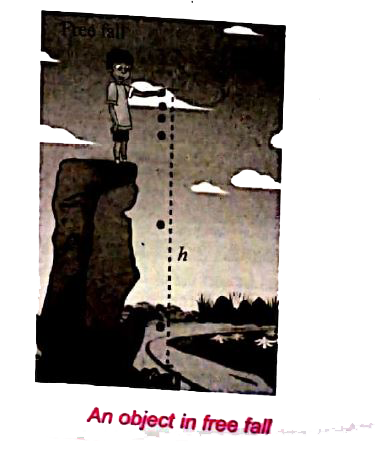Derive the equations of motion for a particle
Falling vertically
Text Solution
A body filling from a height h : Let us consider an object of mass m falling from a height 'h . Let us assume there is no air resistance, The object experiences acceleration 'g' due to gravity that is constant.
a = g
If the particle is thrown with initial velocity 'u' downward that is in negative - Y-aixs, then velocity and position of the particle at any time t is given by
v = u + gt . . . (1)
y=ut+12gt2 ...(2)
When it is at a distance y from the hill -top , is
v2=u2+2gy ...(3)
Suppose the particle starts from rest.
u = 0
For a point y from the hill -top
v = gt
y=12gt2
v2=2gy

|
Updated on:21/07/2023
Topper's Solved these Questions
- BOOK - PREMIERS PUBLISHERSCHAPTER - KINEMATICS EXERCISE - Textbook questions & answers (IV. Numerical problems).48videos
KINEMATICS
- BOOK - PREMIERS PUBLISHERSCHAPTER - KINEMATICS EXERCISE - Other important questions & answers (I.Multiple choice questions).236videos
KINEMATICS
- BOOK - PREMIERS PUBLISHERSCHAPTER - KINEMATICS EXERCISE - Textbook questions & answers (II. Short answer questions).30videos
KINEMATICS
- BOOK - PREMIERS PUBLISHERSCHAPTER - GRAVITATIONEXERCISE - OTHER IMPORTANT QUESTION & ANSWERS (CONCEPTUAL QUESTIONS)34videos
GRAVITATION
- BOOK - PREMIERS PUBLISHERSCHAPTER - KINETIC THEORY OF GASESEXERCISE - OTHER IMPORTANT QUESTIONS & ANSWERS (VI. Conceptual Questions.)8videos
KINETIC THEORY OF GASES
Similar Questions
Knowledge Check
- Question 1 - Select One
The equation of motion of a particle is x=acos(αt)2 .The motion is
Aperiodic but not oscillatoryBperiodic and oscillatoryCoscillatory but not periodicDneither periodic nor oscillatory
Derive the equations of motion for an object in uniformly accelerated motion in one dimension using calculus.
View SolutionDerive the equations of rotational motion for a body moving with uniform angular acceleration,
View SolutionDerive the following equations of motion for uniformly accelerated motion from velocity-time graph : s=ut+12at2
View SolutionDerive the following equations of motion for uniformly accelerated motion from velocity-time graph : v2−u2=2as
View SolutionEquation Of Motion|Free Fall
View SolutionDerive an expression for the difference in tensions at the highest and lowest points for a particle performing vertical circular motion.
View SolutionThe equation of motion of a particle is x=a cos(αt)2. The motion is
View Solution

